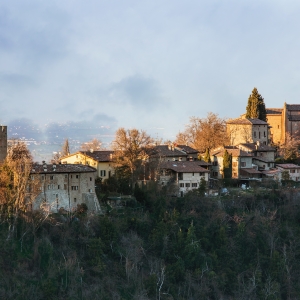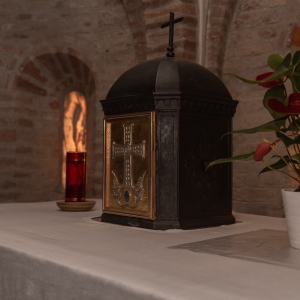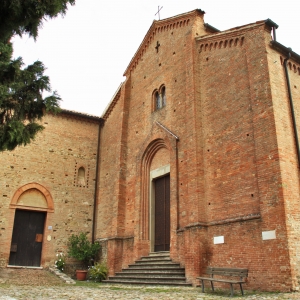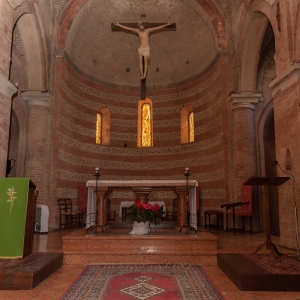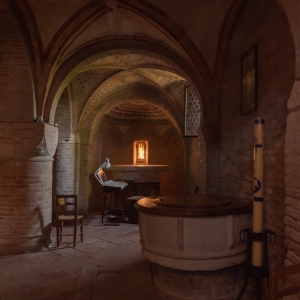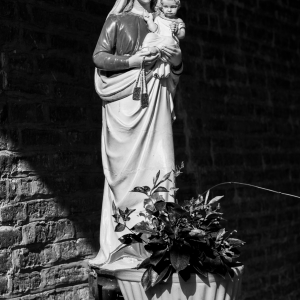
Abbey of Santa Maria Assunta
Valsamoggia
we are translating the content, you can temporarily view the automatic translation of google translate: Link
Where:
Contacts
The Abbey of Monteveglio stands on the top of a hill overlooking the Samoggia valley. It is located within the ancient medieval village founded by Matilde di Canossa in the 11th century. To reach the Abbey, from Monteveglio, a historic town in Valsamoggia, you have to walk along Via Abbazia until the entrance of the castel (coordinates 44.467984177379634, 11.090576897505544). Before the entrace there are parking lots on the side of the road.
The access of the hamlet is an arched gateway, what remains of the ancient fortifications of the village. Above the arched gateway there are still the lifting slots of the drawbridge and the patrol walkway that overlooks a short section of the walls. On the right, immediately after the entrance, there is the recently restored 14th century tower. Adjacent to the tower there is the ancient House of San Benedetto that was for centuries the seat of the oratory and the confraternity of Santa Maria delle Rondini. On the left, there is the bell tower from the 16th century, which at the time was a meeting place for the inhabitants of the village. Going forward, there is the oratory of San Rocco and Sebastiano, a small religious building erected by the inhabitants during the plague epidemic of 1631 and restored at the end of the 19th century.
Continuing along the road that crosses the hamlet, we find the church, dedicated to Santa Maria Assunta, whose origins are very ancient. The church was built in the 1400s, but the current structure date back to the period between the 11th and 12th centuries. The entire complex was restored between 1925 and 1934 by the architect Giuseppe Rivani. The church has a presbytery with three naves, which rises above the crypt. The holy water stoup, located in the right aisle, is from the Lombard period. Accessing the presbitery, in the central nave there is a baroque-style staircase. The altar has five columns and is made of red Verona marble. On the sides of the presbytery there is a wooden structure that houses the choir. In the crypt, placed in the center of the church, there is a tombstone. The area is divided into four bays of columns and pillars with three altars placed in the three apses.
The monastic complex develops around the church.
As soon as it was erected, the monastery was assigned to the Regular Canons of San Frediano di Lucca, an ancient monastic congregation of Augustinian born around 556. The Regular Canons of San Frediano di Lucca arrived in Monteveglio between 1092 and 1100 and remained approximately until 1450. After 1455 the abbey was entrusted to the Lateran Canons of San Giovanni in Monte di Bologna. The Lateran Canons embellished these places with new furnishings and decorations, including a painting by Lorenzo Costa depicting the Assumption, now preserved at the National Gallery (Pinacoteca Nazionale) of Bologna.
In the following centuries the monastery acquired a notable economic prosperity. In the second half of the 20th century the abbey was, for a short time, inhabited by the community of Don Giuseppe Dossetti, a religious and political figure of great historical importance. Today, the abbey is inhabited by the Franciscans of the order of Fratelli di San Francesco.
The Monteveglio Castel is always open to the public. To visit the abbey it is necessary to contact Fratelli di San Francesco at the email address fratimonteveglio@gmail.com or at the telephone number 051 6707931. The Church is open every day from 6:30 am at 12:00 pm and from 3:00 pm to 7:30 pm. While the internal cloister can be visited only on Sundays and holidays from 15.00 to 17.00.
For general information contact: UIT Colli Bolognesi
Tel. +39 366 8982707 - info@visitcollibolognesi.it
Monday - Wednesday-Thursday and Friday 14.30-19, Saturday 9.00-13 and 15-18, Tuesday and Sunday closed
Sources: volume "The Lavino and Samoggia valleys in history" by Michelangelo Abatantuono, Giancarlo Dalle Donne and Elisa Zanoli. with texts by Vittorio Lenzi, Renzo Franceschini, Giuseppe Iannini, Silvia Rubini
Mountain community Union of Municipalities Valle del Samoggia, 2

